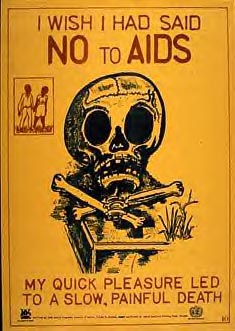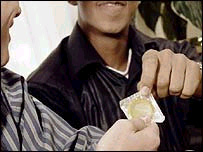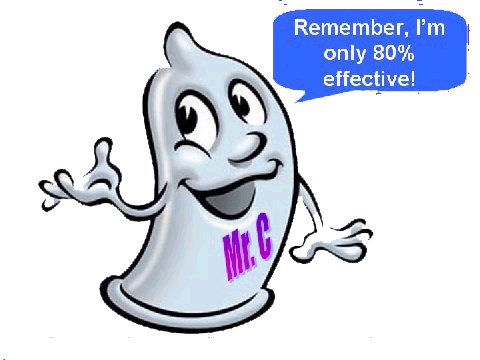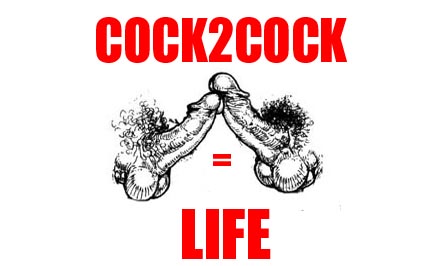




What are they thinking?






What are they thinking?

What are they thinking?
9-4-2006
Here are some of the things we've learned about gay men and HIV in the last two weeks or so:
1. That there's no evidence that condom campaigns have ever been effective.
Source: UC Berkeley epidemiologist Dr. James Chin's forthcoming book The AIDS Pandemic: The collision of epidemiology with political correctness.
2. That a man is most infectious in the period just after he's been infected and before he has antibodies.
That is to say, when he's "negative."
Source: UNC infectious disease expert Dr. Myron Cohen addressing the President's Advisory Council on HIV / AIDS (PACHA).
3. That in the first few weeks after infection, HIV wipes out the T-cells in the gut, and that this is "terrible, irreversible, damage."
Source: Dr. Cohen.
4. That HIV integrates itself into the infected person's DNA.
5. That, in the words of one of the world's leading experts in infectious disease, anal penetration is so traumatic that "you can't win against anal intercourse. It's almost impossible. ... Anal intercourse is a really bad sexual practice for HIV transmission. It changes the equation. The efficiency is probably one in ten or one in eight."
Source: Dr. Cohen.
"Efficiency," roughly speaking, is the number of times *on average* you need to get penetrated -- or penetrate -- before you get infected.
For vaginal it's about 30.
For anal it's about 8 -- says this expert.
Other studies have shown that anal is ten to twenty times more efficient than vaginal.
Source: Halperin, DT, Shiboski, SC, Palefsky, JM, and Padian, N. (2002) High level of HIV infection from anal intercourse: a neglected risk factor in heterosexual AIDS prevention. Poster presentation at the 2002 XIV International AIDS Conference in Barcelona.
Which would put anal at one in three or less.
And remember: you can get penetrated ONCE and get HIV.
I know of so many cases of that happening that I think the "efficiency" of anal transmission is very high: probably about one in three.
6. That MSM HIV prevalence rates are skyrocketing:
"Ongoing incidence rates [rates of new infection] at this level will yield very high HIV prevalence rates within each generation of gay men," University of Pittsburgh researcher Ron Stall told AFP.
Although only one in 12 gay men age 20 was HIV-positive in North America and Europe in 2001, Stall and other researchers project that the rate could rise to one in four by the time they turn 30. At age 60, the projections suggest that 58 percent of the men could be infected.
Over-all, in 2005 HIV prevalence among American gay men was at 25%.
And it's most certainly gone up since then.
7. That 65% of a group of men whose blood was studied starting in 1979 -- before anyone had heard of HIV -- had turned poz by 1984:
HIV prevalence rose from 1 percent in 1980 to 25 percent in 1982 to 65 percent in 1984.
The prevalence curve suggests that by 1983, about half of the MSM cohort, most likely the half with the highest sexual risk behaviors were infected with HIV. After 1983, HIV incidence [the rate of NEW infections] fell sharply because the remaining half of the cohort probably had less risky behaviors and/or there was some overall reduction in sexual risk behaviors as a result of increasing reports of deaths attributed to this "emerging" disease. It should be noted that funding of State HIV/AIDS prevention programs was not started until after 1985.
Source: Dr. Chin.
From one percent to 65% in four years.
Basically, by 84 the group was so saturated with HIV that the rate of new infections dropped radically -- because there was no one left to infect.
Is that still happening?
Yeah:
8. That at the moment in NYC, most new infections are occurring among young gay men.
Why?
The thinking is that all the older guys who are going to get infected, have been infected.
So now it's the turn of the 20-somethings.
Says the Gay City News:
Equally disturbing is that the health department is reporting that new HIV diagnoses increased among all gay and bisexual men under 30 from 2001 to 2004, while new diagnoses among such men over 30 declined.
"Among young, black MSM under 30 there is an increase," Torian said. "There is an increase among young, Hispanic MSM and among young, white MSM."
This could mean that all the gay and bisexual men over 30 who might be infected have been infected -- that the group is saturated -- and the virus is now spreading in a group where there are uninfected bodies.
"The group is saturated."
Just as the group of gay men studied back in the early 1980s had been saturated by 1984.
9. That co-infection with variant and mutant strains of HIV, fed by "sero-sorting" -- poz guys barebacking with poz guys, "neg" guys barebacking with neg guys -- is a growing concern, complicating both treatment and vaccine development efforts.
10. That the HIV / AIDS prevention establishment, in the form of AIDS Service Organizations, is meeting these threats by raising vast sums of money to be spent in condom campaigns and in combatting homophobia.
Question: How many years have condoms been aggressively marketed to MSM?
Answer: About 20.
Question: Has HIV prevalence fallen in that time?
Answer: NO.
It's gone UP.
There was a slight drop in prevalence -- defined as the percentage of guys aged 15 to 49 who are infected -- from 85 to 95 because so many guys died.
Since then, prevalence has risen steadily.
Question: Has anyone ever demonstrated a correlation between homophobia and HIV infection?
Answer: NO.
Indeed, one could argue that homophobia reduces HIV infection because it reduces the level of "gay sex."
Proponents of the anti-homophobia campaign claim that homophobia forces men to have secret male-male sex lives, thus exposing them to HIV.
I agree that homophobia may force certain men to have secret male-male sex lives.
But:
Question: has anyone ever demonstrated a correlation between secret male-male sex lives and HIV?
Answer: NO.
Indeed, many of the men who use this Man2Man Alliance site are married or otherwise closeted and have secret male-male sex lives.
Are they at risk for HIV?
NO.
Not if they're Frot men, as they're supposed to be if they're on this site.
So long as they're not doing anal, and not taking ejaculate in their mouths, their sex lives can be secret or public -- but they won't get HIV.
Secrecy does not transmit HIV.
And combatting homophobia, though a no doubt worthy political goal, is just that -- a political goal, which has no relationship to disease prevention.
Except perhaps a negative one -- since these campaigns inevitably increase the identification of "gay sex" with "anal sex," and thus increase the prevalence of anal itself.
Question: Has anyone ever demonstrated a correlation between anal and HIV infection?
Answer: YES!
Here are some of the more prominent articles from among the extensive peer-reviewed literature on anal transmission of HIV among gay and other men who have sex with men:
* Buchbinder SP, Douglas JMJ, McKirnan DJ, et al. Feasibility of human immunodeficiency virus vaccine trials in homosexual men in the United States: risk behavior, seroincidence, and willingness to participate. J Infect Dis. 1996;174:954-961.
* Coates RA, Calzavara LM, Read SE, et al. Risk factors for HIV infection in male sexual contacts of men with AIDS or an AIDS-related condition. Am J Epidemiol. 1988;128:729-739.
* Darrow WW, Echenberg DF, Jaffe HW, et al. Risk factors for human immunodeficiency virus (HIV) infection in homosexual men. Am J Public Health. 1987;77:479-483.
* van Griensven GJ, Tielman RA, Goudsmit J, et al. Risk factors and prevalence of HIV antibodies in homosexual men in the Netherlands. Am J Epidemiol. 1987;125:1048-1057
* Melbye M, Biggar RJ, Ebbesen P, et al. Seroepidemiology of HTLV-III antibody in Danish homosexual men: prevalence, transmission, and disease outcome. BMJ. 1984;289:573-575
* Ostrow DG, DiFranceisco WJ, Chmiel JS, et al. A case-control study of human immunodeficiency virus type 1 seroconversion and risk-related
behaviors in the Chicago MACS/CCS Cohort, 1984-1992. Multicenter AIDS Cohort Study. Coping and Change Study. Am J Epidemiol. 1995; 142:875-883.
* Seage GRR, Mayer KH, Horsburgh CRJ, et al. The relation between nitrite inhalants, unprotected receptive anal intercourse, and the risk of human immunodeficiency virus infection. Am J Epidemiol. 1992;135:1-11.
* Schechter MT, Boyko WJ, Douglas B, et al. The Vancouver Lymphadenopathy-AIDS Study: 6. HIV seroconversion in a cohort of homosexual men. CMAJ. 1986;135:1355-1360.
* Vittinghoff E, Douglas J, Judson F, et al. Per-contact risk of human immunodeficiency virus transmission between male sexual partners. Am J Epidemiol. 1999;150:306-311.
Typical is Buchbinder et al J Acquir Immune Defic Syndr Volume 39, Number 1, May 1 2005, who state: "Many studies have demonstrated that receptive anal sex is most strongly associated with prevalent and incident HIV infection in MSM and carries the highest per-contact risk of acquiring HIV. ... and should be targeted in prevention strategies for MSM."
Question: According to these studies, how high is the correlation between MSM anal and MSM HIV infection?
Answer: Minimally, 90%.
Some studies put it at 94%.
One study puts it at 99%.
Question: How common is a 90% or better correlation -- in science, or in life?
Answer: Not very.
The correlation between anal penetration and MSM HIV infection is very pronounced and very striking.
Question: Given that correlation, is the HIV / AIDS prevention establishment doing ANYTHING to reduce the level of anal penetration among MSM?
Answer: NO.
Question: What are they thinking?
What are they thinking?
Fact: condom campaigns don't work.
Both Dr. James Chin and Dr. Franklyn Judson have been quoted on this board to that effect:
Dr. Judson:
We never got anywhere [in the 1970s and 1980s] before fear of AIDS[;] and fear of AIDS managed to reduce over a three year period looking backwards through sero-archeology (PH) incident rates for HIV probably 70 to 80 percent then, by the end of the decade probably close to 90 percent. Within three to fours, the incidence of gonorrhea, syphilis had dropped by 90 to 95 percent.
Source: Dr. Judson at the PACHA.
Dr. Chin:
If prevention programs are implemented when HIV epidemics are at or near their "natural" peaks, the subsequent decrease in prevalence might be incorrectly attributed to prevention programs. Yet most of the observed decrease might more likely be due to a saturation effect -- infection of most of the population with the highest risk behaviors. Thus, only a small proportion of the decrease in HIV prevalence might be due to prevention measures. The following section illustrates these problems in attributing reductions in observed HIV prevalence trends to prevention programs.
Decreasing HIV Incidence in an MSM Cohort
Figure 8.2 presents estimates of HIV prevalence and incidence based on point prevalence data from a cohort of MSM in San Francisco. Blood samples were collected from this MSM cohort because they were enrolled in a hepatitis B vaccine study. HIV prevalence rose from 1 percent in 1980 to 25 percent in 1982 to 65 percent in 1984. EPIMODEL was used to fit a prevalence curve to the three HIV prevalence data points and to calculate the annual HIV incidence needed to generate the "fitted" prevalence curve. According to this modeling of the HIV epidemic in this MSM cohort, annual HIV incidence peaked in 1983 at over 20 percent and then decreased sharply and dropped to about 5 percent by 1985.
The prevalence curve suggests that by 1983, about half of the MSM cohort, most likely the half with the highest sexual risk behaviors were infected with HIV. After 1983, HIV incidence fell sharply because the remaining half of the cohort probably had less risky behaviors and/or there was some overall reduction in sexual risk behaviors as a result of increasing reports of deaths attributed to this "emerging" disease. It should be noted that funding of State HIV/AIDS prevention programs was not started until after 1985.
Source: Dr. Chin.
According to both Drs Judson and Chin, it was a combination of fear of death and saturation which reduced the "incidence" -- rate of new infections -- among MSM.
NOT condom campaigns.
INCIDENCE FELL BEFORE CONDOM CAMPAIGNS HAD BEGUN.
And homophobia has nothing to do with HIV.
Do you understand?
"AIDS prevention" is a sham.
It has nothing to do with preventing AIDS.
Homophobia does not create or transmit HIV.
Condom campaigns are at best ineffective in curbing new HIV infections -- and at worst, they encourage men to be anally promiscuous.
Question: Is there an effective and easy way to stop AIDS?
Answer: Yes!
Not doing anal stops AIDS.
NO ANAL
NO AIDS
Yet no one will say so.
What are they thinking?
And what are you thinking?
If you donate to your local AIDS Service Organization -- stop!
Don't do it.
Donate to us instead.
We know how to stop AIDS and all other anally-transmitted diseases.
They don't -- and / or they WON'T.
Recently, Bud Masturs, the guy who posted honorable and sexy, wrote me to say that we're doing more to stop HIV than any AIDS Service Organization.
Because we're actually addressing the behavior which spreads HIV.
And we're looking at that behavior in its cultural context:
A context which denigrates masculinity.
Which denigrates the masculinity of men who have sex with men.
And which supports effeminacy and promiscuity.
Only we look at that culture in depth and critically.
And only we present an alternative:
A culture built on


© All material Copyright 2006 by Bill Weintraub. All rights reserved.
Re: What are they thinking?
9-4-2006
Thanks Bill for this summary of info you've been posting over the past few weeks on HIV. You're right! Only we are presenting an alternative and only we are looking at things culturally in depth and critically. We are advocating a cultural change based on masculinity, phallus, and fidelity. Analism has got to go!!
In Cognitive Psychology there is the basic tenet that states,
"Change the thinking. Change the behavior."
Every action we take in our lives begins with a thought. Sometimes that thought is conscious. Other times that thought is unconscious. But, the fact remains that every action begins with a thought. According to Cognitive Psychology, if you want to change a person's behavior then you must change the thinking. Changing the behavior first and then trying to change the thinking last does not work because all behavior starts with a thought.
That is one of the things I see us trying to accomplish here, that is, changing behavior by first trying to change thoughts. We are presenting thoughts which are masculine, phallic, and rooted in fidelity rather than analism, femininity, and promiscuity. We are presenting an alternative to analism and LIBERATION from the BFD!! By presenting this alternative, these new thoughts, we are attempting to change the behavior and a change in behavior is absolutely ESSENTIAL if AIDS is to be conquered.
Again, thanks for all the latest info on HIV you have been posting. It is all important information that everyone needs to know. A change in behavior first requires a change in thought and that is what we are doing here on this site. It is an effort to save the lives of our brothers and all others who are facing the horrors of AIDS.
Re: What are they thinking?
9-7-2006
Thank you Robert.
A great post making a a very important point:
"According to Cognitive Psychology, if you want to change a person's behavior then you must change the thinking."
The ASOs -- the AIDS Service Organizations -- do NOT want to change the thinking.
They're willing to tinker with it to the extent of telling guys to wear condoms;
But othewise they're committed to preserving the status quo.
No matter how dangerous and dysfunctional that may be.
Now, if gay culture was, let's say, the equivalent of Iroquois culture or Australian aboriginal culture -- something which had existed for millenia and which was worth preserving -- that would be one thing.
But gay culture is not an aboriginal culture.
Gay culture is essentially an unhappy blend of sexual libertinism, gender feminism, and American consumerism.
And it's very recent.
Not just the emphasis on anal, but the culture itself is only about 30 years old.
Clearly it has room to evolve and change.
Yet the effect of the messages generated by the ASOs has been to freeze it in a moment of time.
Further, the attitude of the ASOs is patronizing and in essence, colonialist.
We're the professionals, they say, and we know best.
So they routinely withhold information -- in effect, treating their target audience and "clients" like children.
For example, I took care of someone with HIV / AIDS for seven years -- but I didn't know until last week that HIV INTEGRATES ITSELF into the DNA of the host.
That's really creepy.
And I would tell people that.
Loud and clear.
That's what they did in Uganda.
And it worked.
They used fear -- which was justified because this is a fearsome disease:

We routinely label arsenic and like poisons with a skull and crossbones.
Why not HIV?
Or anal penetration -- the behavior which spreads HIV and so many other diseases:

Dr Judson speaking at the PACHA:
We never got anywhere [in the 1970s and 1980s] before fear of AIDS[;] ... This is the power of change in behavior. We couldn't measure it. There were no CDC prevention programs at the time. These were gay men understanding how their sexual behavior probably spread this deadly condition.
"fear"
"sexual behavior"
"deadly condition"
Interestingly, in something else we reported on out of Toronto, people in Swaziland, which was condom-campaigned literally to death, said they want a Ugandan-style prevention campaign which doesn't mince words:
" 'You should show people dying of AIDS, you should scare people'," [said the locals.] Halperin [the researcher] said. "We're seeing a bit of a disconnect between what people in the community say and what we, as experts, believe is the right way to do AIDS prevention."
But who knows better -- the people in the community?
Or the so-called experts?
Halperin by the way is the guy who did the study showing that anal is ten to twenty times more dangerous than vaginal.
He presented his findings as a "poster board" in Barcelona in 2002.
But he's never formally written them up.
I wonder why?
Dr. Cohen informed us that people are most infectious after they've been infected but before their bodies have time to develop antibodies which will appear on a test.
Which means that a person can test "negative" while being super-infectious.
Right now the big push is for people to get tested.
That's fine in terms of starting treatment.
But the message needs to go out that EVEN IF A PERSON TESTS NEGATIVE, HE MAY STILL HAVE THE DISEASE AND BE VERY DANGEROUS.
And Dr. Cohen told us that you can't win against anal:
the efficiency of rectal intercourse changes everything because of the number of dendrite cells, receptors and trauma. So you can never overwhelm, you can't win against anal intercourse. ...
Anal intercourse is a really bad sexual practice for HIV transmission. It changes the equation. The efficiency is probably one in ten or one in eight.
And as I said, I think the efficiency is higher -- more like one in three.
But either way, the essential message is: "You can't win against anal."
The only logical conclusion you can reach from this information is that you MUST AVOID THE RISK BEHAVIOR -- anal penetration -- because that's the only way you can reasonably expect to stay "safe."
So that information needs to go out:
That's what needs to go out.
NOT: use a condom every time, every time.
So:
The first step in changing the thinking is to tell the TRUTH.
We have to tell the truth about anal.
And risk.

|

This review indicates that consistent use of condoms results in 80% reduction in HIV incidence. Consistent use is defined as using a condom for all acts of penetrative vaginal intercourse. Because the studies used in this review did not report on the "correctness" of use, namely whether condoms were used correctly and perfectly for each and every act of intercourse, effectiveness and not efficacy is estimated. Also, this estimate refers in general to the male condom and not specifically to the latex condom, since studies also tended not to specify the type of condom that was used. Thus, condom effectiveness is similar to, although lower than, that for contraception.
Citation: Weller S, Davis, K. Condom effectiveness in reducing heterosexual HIV transmission (Cochrane Review). In: The Cochrane Library, Issue 1 2003. Oxford: Update Software.
Many studies have demonstrated that receptive anal sex is most strongly associated with prevalent and incident HIV infection in MSM and carries the highest per-contact risk of acquiring HIV. This study found that URA [unprotected receptive anal] with either HIV-positive or unknown serostatus partners explained one quarter of new infections in this cohort. Surprisingly, we also found an independent increase in the risk of HIV seroconversion among men reporting PRA [PROTECTED receptive anal] with an HIV-positive partner. This finding likely represents a combination of overreporting of condom use and unrecognized condom failure by the receptive partner. Condom failure rates are particularly increased among MSM who use condoms infrequently, substance users, and those failing to use appropriate lubricants.
The Surgeon General of the United States:
Are condoms strong enough for anal intercourse?
The Surgeon General has said, "Condoms provide some protection, but anal intercourse is simply too dangerous to practice."
Condoms may be more likely to break during anal intercourse than during other types of sex because of the greater amount of friction and other stresses involved.
Even if the condom doesn't break, anal intercourse is very risky because it can cause tissue in the rectum to tear and bleed. These tears allow disease germs to pass more easily from one partner to the other.

Robert:
We are presenting thoughts which are masculine, phallic, and rooted in fidelity rather than analism, femininity, and promiscuity. We are presenting an alternative to analism and LIBERATION from the BFD!! By presenting this alternative, these new thoughts, we are attempting to change the behavior and a change in behavior is absolutely ESSENTIAL if AIDS is to be conquered.
Right.
"We are presenting thoughts which are masculine, phallic, and rooted in fidelity..."
Because masculinity and attitudes about masculinity are key to changing the behavior.
When I wrote to Martin Ssempa, the Ugandan pastor and ABC advocate, re MSM issues, I said to him, "There's not one homosexuality, there are many homosexualities."
And how those homosexualities manifest depend upon the *thinking* which is guiding the behavior.
That's why Masculinity is key.
Because a man who understands what true, Natural Masculinity is and thinks of himself as Masculine will not do things nor allow things to be done to him which destroy his Masculinity.
Whereas males who think that being "gay" means being "effeminate" will accept anal penetration as their lot in life.
This is something we talked about in the message thread men without marriage:
Men who *think* they're less than masculine are more easily acculturated into analism.
Men with a strong masculine ID don't want to go there.
And you can read more about the influence of masculine-identification on sexual behavior in Loving a Man as a Man: Creating a Masculine, Socially-dignified Space.
So the key, as Robert has said, is changing the fallacious thinking:
"If I'm a man who's into other men, I'm less than masculine."
"If I'm a man who's into women, but I'm also interested in other men, I musn't act on it, because then I'll be less than masculine."
Men need to understand that being into other MEN is a function of MASCULINITY.
BEING INTO OTHER MEN IS PART OF BEING A MAN.
A MASCULINE MAN.
Man is good.
Man2Man is good.
Guys who understand that it's NATURAL for a MASCULINE MAN to LOVE another MAN --
and that the NATURAL WAY for MEN TO LOVE MEN IS PHALLICALLY --
will choose FROT --
Because there's nothing more powerful, nothing more intense, nothing more male.
Fight back guys.

© All material Copyright 2006 by Bill Weintraub. All rights reserved.






AND


Warriors Speak is presented by The Man2Man Alliance, an organization of men into Frot
To learn more about Frot, ck out What's Hot About Frot
Or visit our FAQs page.


© All material on this site Copyright 2001 - 2010 by Bill Weintraub. All rights reserved.



PHALLUS
FIDELITY
